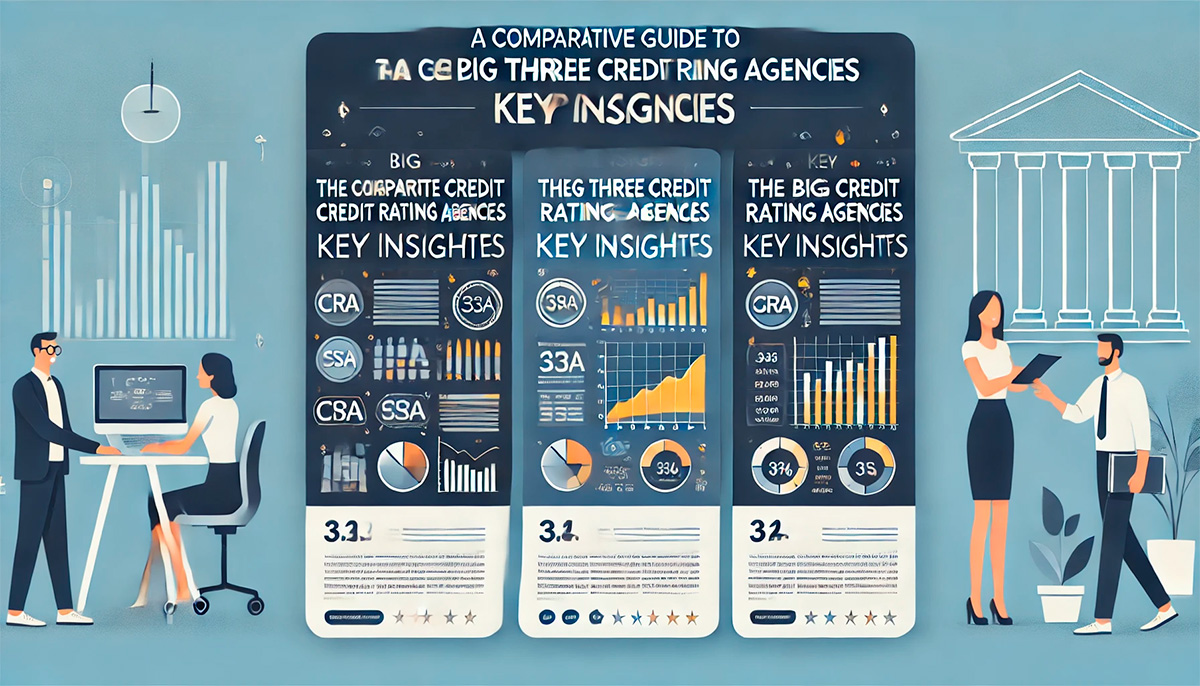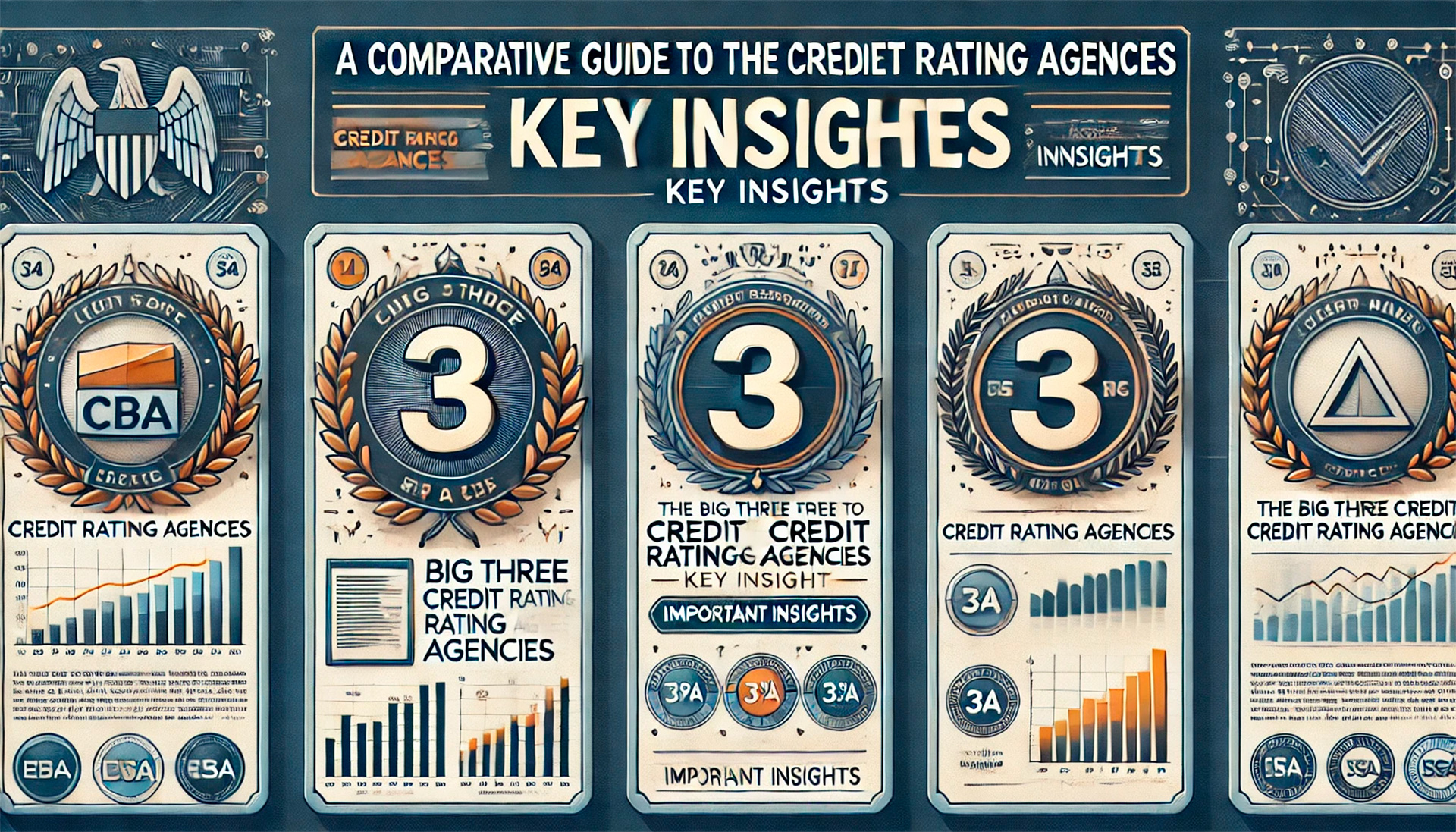A Comparative Guide to the Big Three Credit Rating Agencies
The Big Three credit rating agencies-S&P Global Ratings, Moody’s Investors Service, and Fitch Ratings-play a crucial role in the financial world. They assess the ability of organizations to repay debts by thoroughly analyzing financial statements, management performance, and market conditions. High ratings from these agencies suggest low risk, while low ratings flag potential trouble, directly impacting investment decisions.
Each agency has distinct rating methodologies. Moody’s employs a scale from Aaa to C, with numerical modifiers, while S&P and Fitch use a range from AAA to D, adding pluses and minuses. S&P and Fitch consider BBB- and above as investment-grade, whereas Moody’s considers Baa3 and above. This nuanced differentiation helps investors make well-informed decisions in gauging creditworthiness and navigating the market’s complexities.
These agencies hold immense sway, controlling about 95% of the global credit rating market. Unfortunately, during the 2007-2008 financial crisis, their overly optimistic ratings on complex securities misled investors, exacerbating the meltdown. Despite criticisms over their issuer-paid models and opaque methodologies, S&P, Moody’s, and Fitch remain influential, shaping global financial markets. Engaging with these insights can sharpen your investment strategies and risk assessments.
What Are The Big Three Credit Rating Agencies And What Do They Do?
The Big Three Credit Rating Agencies are S&P Global Ratings (S&P), Moody’s Investors Service, and Fitch Ratings. You might wonder what these agencies actually do. They evaluate the financial health of large entities, including companies and governments, to determine their ability to repay debt. They do this by analyzing financial statements, management performance, market conditions, and economic trends.
- Moody’s Investors Service: They use a rating scale from Aaa (highest quality) to C (lowest quality) to rate debt instruments and securities.
- S&P Global Ratings: The oldest of the Big Three, S&P’s ratings range from AAA (extremely strong capacity to meet financial commitments) to D (payment default).
- Fitch Ratings: The smallest, with a similar rating scale to S&P, Fitch also provides widespread financial coverage and unique rating methodologies.
You can use these ratings to make informed decisions about where to allocate your money. Generally, a higher rating means lower risk when lending to or investing in an organization. Despite their crucial role, the Big Three have faced criticism for their actions before the 2008 financial crisis and during the European sovereign debt crisis.
Bringing it all together, the Big Three Credit Rating Agencies—S&P, Moody’s, and Fitch—assess financial health to guide your investment decisions, with higher ratings indicating lower risk.
How Do S&P, Moody’S, And Fitch Differ In Their Rating Methodologies?
When comparing S&P, Moody’s, and Fitch, you should know that these credit rating agencies have distinct methodologies and rating scales.
Moody’s uses a scale from Aaa to C with numerical modifiers (1, 2, and 3), while S&P and Fitch use a scale from AAA to D with plus (+) and minus (-) signs indicating relative standing. For investment-grade ratings, S&P and Fitch classify BBB- and above as investment-grade, while Moody’s uses Baa3 and above.
In terms of methodology, S&P focuses on qualitative and quantitative credit risk factors, Moody’s emphasizes qualitative aspects such as management quality and market position along with financial metrics, and Fitch combines both qualitative and quantitative models, emphasizing the issuer’s financial flexibility and strategy.
Considering market share, S&P and Moody’s each control around 40% while Fitch holds about 15%. In terms of global reach, S&P and Moody’s are predominantly US-based, whereas Fitch operates with dual headquarters in New York and London.
All things considered, understanding the different methodologies and rating scales of S&P, Moody’s, and Fitch helps you make informed decisions about credit risk assessments and navigate investment options more confidently.
Why Are The Big Three Credit Rating Agencies So Influential In The Financial Markets?

The Big Three Credit Rating Agencies—S&P Global Ratings (S&P), Moody’s, and Fitch—are highly influential in the financial markets for several reasons:
Firstly, you should know that these agencies dominate about 95% of the global credit rating market. Moody’s and S&P each hold around 40%, while Fitch commands around 15%. Their broad reach and numerous ratings make them pivotal players.
You can see their influence in regulatory backing. These agencies are designated as Nationally Recognized Statistical Rating Organizations (NRSROs) in the United States and have similar recognition in Europe. This means institutions often need to consider their ratings when making investment decisions due to government regulations.
Investors rely heavily on these ratings. Whether you’re a retail or institutional investor, you depend on their evaluations to gauge the creditworthiness of debt issuers, whether corporate or sovereign. This reliance influences trillions of dollars in investments worldwide.
Credit ratings became a norm after 1936 when federal banking regulations prohibited banks from investing in low-rated speculative bonds. This practice extended to other financial institutions and markets globally, adding historical weight to their influence.
These agencies offer an independent evaluation of credit risk associated with debt securities. This helps you decide the level of risk you are willing to take, impacting interest rates and investment choices.
By assigning ratings, they signal the financial health and stability of entities, whether companies, municipalities, or countries. These ratings affect everything from interest rates on loans to the ability of entities to access capital markets.
Lastly, despite facing criticism, especially after the 2008 financial crisis for failing to predict the collapse of financial institutions and mortgage-backed securities, their ratings continue to play a fundamental role in financial decision-making and maintaining market stability. This is why the Big Three Credit Rating Agencies remain so influential in the financial markets.
What Was The Role Of The Big Three Credit Rating Agencies In The 2007-2008 Financial Crisis?
During the 2007-2008 financial crisis, the Big Three Credit Rating Agencies—Moody’s, Standard & Poor’s, and Fitch Ratings—played a significant role in worsening the situation. These agencies provided overly high ratings to complex securities, including mortgage-backed securities, giving you and other investors false confidence in their safety.
You relied heavily on these ratings, but the agencies failed to accurately assess the risks associated with securities tied to subprime mortgages. When these subprime mortgages started to default, the securities lost value quickly, causing massive financial losses for many, including major institutional investors like pension funds.
Critics, including the Financial Crisis Inquiry Commission, branded the agencies as “”key enablers of the financial meltdown.”” Their flawed ratings allowed the financial system to take on excessive risk. Eventually, hundreds of billions of dollars’ worth of securities were downgraded to “”junk”” status, leading to the collapse of investment banks like Bear Stearns and Lehman Brothers.
You can see how the reliance on these agencies created a conflict of interest, as they were paid by issuers to rate the securities. This compromised their objectivity and led to inflated ratings. Even with reforms like the Dodd-Frank Act aimed at increasing accountability, the fundamental business model and market dominance of the Big Three have largely remained unchanged.
Finally, understanding the role of the Big Three Credit Rating Agencies in the crisis helps you grasp why their inflated ratings and systemic flaws were crucial in spiraling the financial meltdown.
How Do Credit Ratings From S&P, Moody’S, And Fitch Impact Investment Decisions?
“Credit ratings from S&P, Moody’s, and Fitch significantly impact your investment decisions. These ratings serve as a guide to assess the level of risk associated with investing in bonds or stocks.
- Risk Assessment: Higher ratings (such as AAA from S&P and Fitch or Aaa from Moody’s) indicate lower risk of default, while lower ratings suggest financial instability and higher risk.
- Interest Rates: Bonds with high credit ratings generally offer lower interest rates due to their lower risk. Conversely, lower-rated bonds (often called “junk bonds”) offer higher interest rates to compensate for the elevated risk.
- Investment Restrictions: Many institutional investors (like pension funds and insurance companies) can only invest in bonds of investment grade (BBB- or better from S&P and Fitch, Baa3 or better from Moody’s). These ratings thus directly influence which securities they can buy.
- Market Perception: Credit ratings affect how the market perceives a company’s financial health and its ability to raise capital. A downgrade can increase borrowing costs and lower stock prices, while an upgrade can have the opposite effect.
In closing, by understanding how credit ratings from S&P, Moody’s, and Fitch influence risk assessment, interest rates, investment restrictions, and market perception, you can make more informed investment decisions and better manage your portfolio.”
